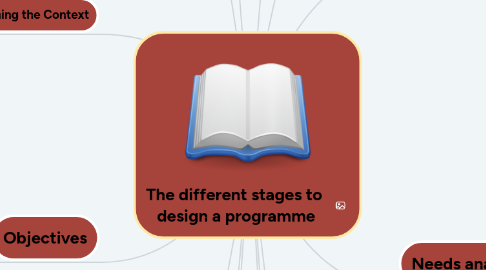
1. Curriculum
1.1. educational program
1.1.1. states:
1.1.1.1. educational purpose
1.1.1.2. teaching procedures
1.1.1.3. learning experience
1.1.1.4. means for assessing
1.2. to planning
1.2.1. educational program
1.2.1.1. involves factors:
1.2.1.1.1. philosophical
1.2.1.1.2. social
1.2.1.1.3. administrative
1.3. encompasses
1.3.1. components:
1.3.1.1. purposes
1.3.1.2. content
1.3.1.3. methodology
1.3.1.4. evaluation
1.3.1.5. process
1.3.2. to evaluate curricula
2. Course
2.1. series
2.1.1. teaching-learning experiences
2.2. aim
2.2.1. particular state of knowledge
2.2.1.1. societal needs analysis
2.2.1.2. testing
3. Syllabuses
3.1. what should be taught
3.2. contain
3.2.1. method of teaching
3.2.2. time to be taken”
3.3. is based on
3.3.1. what happens
3.3.1.1. on classroom
4. Articulating your beliefs
4.1. view of language
4.1.1. self expression
4.2. social context of language
4.2.1. harmony or in conflict
4.2.1.1. learners
4.3. view of learning and learners
4.3.1. learning is deductive or inductive process
4.3.2. Learners have:
4.3.2.1. affective
4.3.2.2. cognitive
4.3.2.3. social needs,
4.4. r view of teaching
4.4.1. knowledge transmission
5. Defining the Context
5.1. factors
5.1.1. People: Students
5.1.2. Physical setting: Location of school.
5.1.3. Nature of course and institutions: Type, purpose of course
5.1.4. Teaching resources: Materials available
5.1.5. Time: How many hours
6. Aims
6.1. provides:
6.1.1. reason for the program
6.1.2. guidelines for teachers and learners
6.1.3. focus for learning
6.1.4. changes in learning
7. Objectives
7.1. more specific than aims
7.1.1. consistent with the curriculum aim
7.1.2. precise
7.1.3. feasible
8. Needs analysis
8.1. Participant;
8.2. Purposive domain
8.3. Setting
8.4. Interaction
8.5. Instrumentalit
8.6. Dialect
8.7. Target level
8.8. Communicative event
8.9. Communicative key
9. What stages are followed in designing a course?
9.1. Structural
9.2. Situational
9.3. Topical
9.4. Functional
9.5. Notional
9.6. Skills
9.7. Task
10. Shape of the Syllabus
10.1. The Linear Format
10.1.1. Teachers cannot change the order of units or skip some.
10.2. The Modular Format
10.2.1. integrate thematic or situational contents
10.3. The Cyclical Format
10.3.1. teachers and learners to work with the same topic
10.4. The Matrix Format
10.4.1. flexibility to select topics
10.5. The story-line format
10.5.1. is a narrative.
11. Organizing the course
11.1. Determining the organizing principle(s) (e.g.., themes, genres, tasks)
11.2. Is based on the organizing principle(s)
11.3. Sequencing the units
11.4. Determining unit content
11.5. Organizing unit content
12. Language Testing
12.1. used to drive a programme
12.2. different types of tests:
12.2.1. norm-referenced,
12.2.2. criterion-referenced
13. Materials
13.1. students’ needs, objectives, tests.
14. Evaluation
14.1. purposes
14.1.1. To decide whether a programme has had the intended effect
14.1.2. To identify what effect a programme has had
14.1.3. To justify future courses of action
14.1.4. To identify areas for improvement

